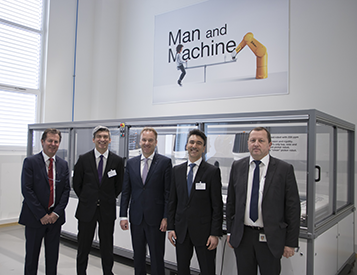
Stäubli and Schneider Electric sign partnership to integrate robotics
Mike Edwards
News partnership Schneider Electric The new Stäubli robotics showroom in Faverges, France. Left to right: Jean-Marc Dalmasso, Deputy Business Unit Manager, Stäubli Faverges Andrea Barbolini, VP, Solutions Management, Machine Solutions, Schneider Electric Gerald Vogt, Group Division Manager, Stäubli Robotics Ali Haj Fraj, SVP Machine Solutions, Industry Business, Schneider Electric Yves Gelon, Robotics Division Manager, Stäubli Faverges.
The new Stäubli robotics showroom in Faverges, France. Left to right: Jean-Marc Dalmasso, Deputy Business Unit Manager, Stäubli Faverges Andrea Barbolini, VP, Solutions Management, Machine Solutions, Schneider Electric Gerald Vogt, Group Division Manager, Stäubli Robotics Ali Haj Fraj, SVP Machine Solutions, Industry Business, Schneider Electric Yves Gelon, Robotics Division Manager, Stäubli Faverges. Stäubli Robotics and Schneider Electric have further developed their partnership by signing a long-term agreement to integrate customized Stäubli TS series four axis SCARA robots into Schneider Electric’s EcoStruxure Machine architecture and platform. EcoStruxure is Schneider Electric’s IoT-enabled, open and interoperable system architecture and platform.
It delivers Innovation At Every Level across connected products, edge control, and apps, analytics, and services, with domain expertise in machinery to enable smart machines by combining products and software packages into automation solutions for OEM machine builders.
Stäubli Robotics develops specialized, professional robotics solutions for every industry, including electronics, medical, automotive, food, plastics processes, mechanics, and painting. It offers a unique and comprehensive line of four axis TP fast pickers and TS SCARA robots, as well as six axis TX and TX2 collaborative robots.
Schneider Electric is integrating a customized version of the Stäubli TS series four axis SCARA robots into its solution portfolio. Labeled Lexium STS series, these robots will now be fully integrated into the architecture of Schneider Electric´s leading PacDrive motion control solution.
There are two main benefits this integration brings to industrial customers – firstly programming robot movements becomes much simpler by using a common programming language standardized on IEC 61131-3 – time taken for familiarization with special robotics programming languages becomes a thing of the past. Secondly, and related, are the benefits of omitting proprietary robot control from the hardware installation of an automation system – this reduces the number of interfaces, the wiring effort and the installation space required.
Print this page